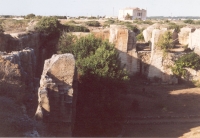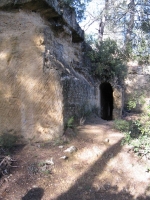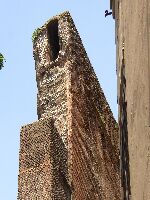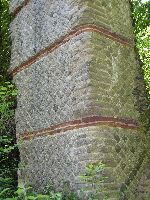



Construction materials
An engineer or artisan must work within the constraints imposed by his materials and skills; these limit his ability to shape, transport and handle materials and finished goods. The growth and stability of Rome was in large part due to the richness of its site and the neighbourhood in a variety of excellent building materials that were available to Roman engineers and artisans. The material varied in quality and over time.Stone, brick and tile
Building stone was quarried as early as 2800 BC The Egyptians quarried soft rocks like limestone, but they also managed harder materials like sandstone, serpentine, basalt and granite (O'Conner, 1993: 51). This was accomplished with wood, stone and bronze tools. O'Conner (1993:51) mentions the Egyptians were able to saw limestone using copper blades fed with sand or set with emery teeth. This technology was passed on to the Romans via the Greeks.Tufa, or tuff, is a compressed volcanic ash. It is common in Italy and available in three forms - stony (tufa litoide), employed as a building stone; granular (tufa granulare), too soft for building stone but forms the chambers of catacombs; and sandy (pozzolana), used in hydraulic cement (hydraulic cement is a cement that is capable of hardening underwater). O'Conner (1993:51), quoting M.E. Blake, subdivides the building tufas; capellaccio, a widespread, very soft rock that was taken from the first layers of ash that fell near Rome; Fidenae tufa from the second layer; and Grotta Obscura, Monte Verde and Anio tufa from third. The fourth discharge of ash resulted in a layer of stone consisting of hard, dark gray tufa containing fragments of dark lava, white limestone and other materials. This was called peperino, due to its speckled appearance. A similar, but coarser, stone is Gabine stone. The better of these materials for building appear to have been Monte Verde, Anio tufa and peperino.
Tufa was the only stone used during the early prehistoric period of Rome, because it was both near at hand and could be worked with the available bronze tools. Simply removing the covering earth and removing the required material using hammer and chisel was all that was needed. A simple coat of stucco is sufficient to protect it from the weather, and was probably never used externally without this protection (Middleton, 1892a:5).
Lapis Albanus, modern peperino, is a conglomerate of ashes, gravel and other fragments of stone, all cemented together into a dense mass. It is moderately good for outdoor use, and is fireproof. It was used in parts of the Servian wall and at the exit of the Cloaca Maxima (Middleton, 1892a:6).
Lapis Gabinus, also called peperino is similar to Lapis Albanus, but contains less mica, is harder and more weather resistant. It contains broken fragments of lava, the product of some earlier eruption. The Tabularium is faced with Lapis Gabinus, the inner walls are of tufa. In the circuit wall around the Forum of Augustus both the Alban and Gabine stones are used, and the difference in their abilities to withstand weathering can be easily compared. The lower part of the wall is Gabine stone, and is fresh and sharp; while the upper story is of Alban stone and show considerable signs of weathering. Tacitus (Annals, 15.43) tells us that Nero enacted a law that required Gabine stone to be used for fronts of houses in the streets of Rome, because of its fire-resistant properties. This occured after the great fire (Middleton, 1892a:7).
Vitruvius (2.7) mentions some of these stones. He also refers to travertine (lapis travertinus), quarried near Tivoli or Tibur, on the banks of the River Aniene. Travertine is calcium carbonate, or hard limestone rock, deposited by hot springs, formed in a highly stratified state with frequent cavities and fissures. In it are frequently embedded bits of petrified leaves and sticks. It is strong and durable, and also has a pleasing appearance and texture, starting out with a creamy colour and weathering into a rich golden tint. In was normal building practice to face tufas with other materials, but travertine was used as both structure and facing. Vituvius mentions that it is a strong material, but also states that it is readily susceptible to fire damage. Note: when burnt, it produces high quality lime. It contributed to the durability of Roman concrete, cements and mortar. One of the earliest known uses of travertine is on the bridge Pons Milvius in 109 B.C. One of the most conspicuous uses is the exterior of the Colosseum.
Silex (there is no relation to modern silex, which is flint) is simply lava, was used to pave roads and broken into pieces and mixed with lime and pozzolana to form concrete. Silex is hard and dark gray in colour (Middleton, 1892a:8).
Pulvis Puteolanus, modern pozzolana existed in great quantities around Rome and Puteoli, near Naples, from which it took its name. Colour ranges from brown to brownish red and resembles a clean sandy earth mixed with larger lumps about the size of coarse gravel. The brown stone was of inferior quality and was used mostly after the 3rd century AD. This fact is a useful guide to date existing buildings. When Pulvis Puteolanus is mixed with lime it forms a strong hydraulic cement. Vitruvius devotes chapter six of his second book to this important material, without which the Pantheon and great vaulted Thermae would not have been possible.
High quality sand (arena) and gravel (glarea) can be found in great quantity near Rome and contributed to the strength of Roman mortar and cement. Vitruvius mentions three kinds of sand, with arena fossitia, or pit-sand, being of the highest quality, and arena fluminibus, or river-sand, next best. No sand could be better for building purposes than the golden pit-sand of the Janiculan Hill. That which the Tiber deposits is not free from muddy impurities. Arena marina, or sea-sand, is of the lowest quality and is to be avoided for building purposes because of the salt it contains efflorescing out from the mortar or stucco (Middleton, 1892a:10). Vitruvius states that the highest quality sand can be judged by its crackling when rubbed in the hand, and by its not staining a white dress. This shows that it is both sharp and clean.
Bricks were of two types, lateres, or sun-dried, and testae or tegulae, or kiln-baked. Vitruvius writes only about lateres (2.3), and curiously never mentions the common triangular bricks that were used in all the existing Roman walls which have brick facings. His chapter on sun-dried bricks is of great interest, as it records the methods used by the Greeks as well as the Romans used to prepare this important building material. The clay was to be carefully selected and exposed to the weather for two years before being made into bricks. It was then thoroughly beaten, mixed with chopped straw and moulded into shape. They were then put in the sun to dry, but only used after a long time had been allowed to elapse. Vitruvius (2.3.2) states that, at Utica, bricks had to be kept for five years and then approved by a magistrate before they could be used. As long as they were protected by a coat of stucco these bricks were perfectly durable (Middleton, 1892a:11). In some bricks, mainly those of high quality, a quantity of red pozzolana was included with the clay, probably to prevent warping.
The existing examples of bricks in Rome are used as facing to concrete walls. No wall seems to have been made of bricks only. These facing bricks are not rectangular, but are equilateral triangles, varying in length from 10 to 35 centimetres, with 25 centimetres being the commonest size. Though the bricks for any particular wall are usually of regular size, their apparent length when seen in the face of the wall could seem to vary a great deal. This is because one or more of the sharp points of the triangle might have been accidently broken off before being set into the wall (Middleton, 1892a:11). The bricks were laid with their ends being placed as near as possible over the centres of the triangles in the course below. The bricks (and tiles) in Roman buildings are of many colours, usually red or yellow, less commonly brown.
The sigilla, or stamps, which occur on the bricks of buildings of Imperial date in Rome are of great value in determining the dates of various structures. In other places in Italy brick stamps occur as early as the middle of the 1st century BC. In Rome the complete series does not begin until after the 1st century AD, and continues until circa 500 AD, in the reign of Theodoric, though not without interruptions. The inscriptions of the 2nd and 3rd centuries are usually circular, with the inscription in two concentric rings. The later stamps are usually rectangular.
Various names and facts are recorded on these stamps, such as the names of consuls or (more frequently) the owner of the brickfield from which the clay came, and that of the figulus, or potter, who made the brick. The words ex praediis denote the estate where the clay was dug, after it comes the name of the owner, very often the Emperor. Severus appears to have owned many praedia, which supplied the bricks used in his palace on the Palatine. The potter's name comes after the words opus doliare or opus figlinum, meaning "clay-work", or else ex figlinis or ex officina, meaning "from the pottery" or "manufactory". After the potter's name the phrase Valeat qui fecit frequently occurred, wishing the maker prosperity (Middleton, 1892a:13).
The use of brick stamps appears to have been enforced by law. This was probably in connection with a tax that was levied on bricks and tiles (Middleton, 1892a:13). The following is a example of a tile-stamp inscription in concentric rings.
EX · PRAE[DIIS] · DOMITIAE · LVCILLAE · EX · FIG[VLINUS] DOMIT[IANIS] · MINORIB[VS] · OP[VS] · DOL[IARE] · AELI · ALEXANDRIThe facings of arches are nearly always made with large square tiles, about two Roman feet square. Vitruvius named these tegulae bipedales. They are usually cut into three or four pieces so as only to tail a few inches into the concrete arch which they hide. At intervals in each arch a few of the complete squares are introduced to improve the bond. Tiles of 30, 36 and 46 centimetres square also occur, but less commonly. There are also the small squares of about 21 centimetres which were used for the pilae of hypocausts, and also for laying over the wooden centering into which the fluid concrete to form vaults was poured.
Concrete
Concrete was one of two discoveries near the end of the Republican period that would immeasurably enrich the store of construction materials available to the Romans (the other being kiln-baked bricks, or testae). In the vicinity of Mount Vesuvius, near Puteoli, a reddish volcanic soil was found that had useful properties. When mixed with lime, pottery fragments, sand and water in the correct proportions, a plastic mass would form that would harden, even under water, into a durable material. This material was called pulvis Puteolanus, and was used in construction until the invention of portland cement (19th century).Lime was manufactured by the Romans by burning limestone in kilns and then slaking in water. The first process reduced calcium carbonate to calcium oxide, or quicklime. The addition of water converts this to calcium hydroxide, or slaked lime. Vitruvius describes this process in 2.5.1-3 and 7.2. He advised the selection of white stone, and knew of the importance of thorough slaking before use. Lime has the capacity of hardening on exposure to air; calcium hydroxide combines with carbon dioxide to form calcium carbonate, the substance from which it was originally formed (O'Conner, 1993: 57).
The use of lime with sand and water to a hardening mortar was known to the Greeks, who passed on the knowledge to the Romans (O'Conner, 1993:57). The Romans in turn were able to devise or discover a means of converting this to a hydraulic cement.
It was only towards the end of the first century BC that concrete became a commonly used building material. Thus most of the aqueduct bridges used concrete. However, as many of the bridges had to be repaired and even strengthened over a period of hundreds of years, the bridges are mixtures of different materials, styles and dates (Hodge, 2002:130). Thus we find older bridges that are partially constructed with concrete; this is misleading, however, as the concrete was added later, probably to provide additional strength, as bridges were expected to carry loads exceeding that of their original design, as new aqueducts were placed above or alongside existing ones.
From the thesis of Evan J. Dembskey on The aqueducts of Ancient Rome